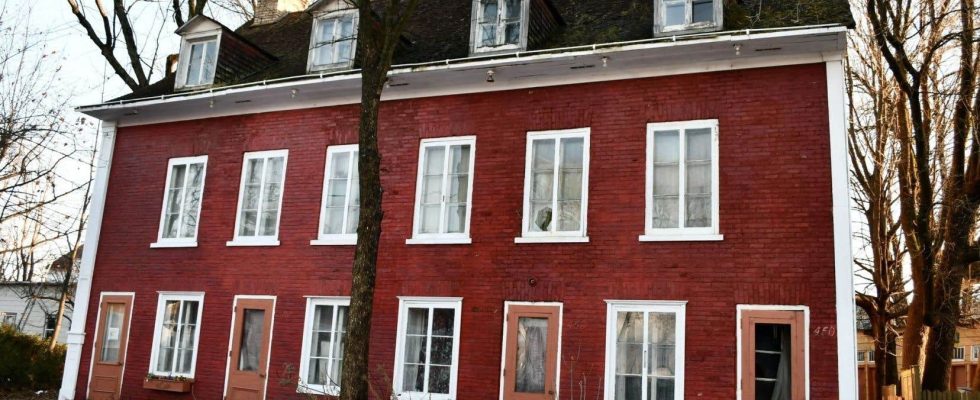The upcoming demolition of a building built between 1850 and 1860 and yet not classified as heritage is once again causing discontent in Lévis. 450, rue Saint-Joseph risks being added to an already long list of century-old buildings erased from the Lévis landscape in recent years, often following abandonment for which the owners receive very few penalties.
At first glance, the 450 still exudes a certain pride: the four brick facades still stand, pierced by abundant windows, spread over two floors, and topped by six dormer windows. Two chimney stacks emerge, very straight, at each end of the roof, and the scale of the place still allows us to glimpse the splendor of traditional Quebec houses of yesteryear.
From the outside, the apartment building hides its decrepitude well. The interior, however, eloquently bears witness to 40 years of neglect. It is a shambles that has become the kingdom of rot: jumbled objects eaten away by fungi, a roof that lets water and light in in places, broken floors, leaky plumbing. An inspection report commissioned by Lévis and submitted last November “doubts whether it is viable to restore this building rather than demolish everything and rebuild.”
The same owner, Robert Paquet, owned the century-old building for 44 years, from 1972 to 2016. He suffered from Diogenes syndrome, according to the town planning department of the City of Lévis, and compulsively accumulated objects in the building, without heating or occupying it for more than 40 years. Already in 1999, an inspection report noted the advanced state of disrepair of the place and justified its demolition.
On December 12, the City’s demolition committee granted the request submitted in the summer of 2023 by Jean-Claude Croteau. The latter, owner of the premises since 2016, convinced the three members of the committee, all municipal elected officials, of the irrecoverable state of his building.
Contested demolition
Some, however, contest the condemnation of the building, which does not benefit from any particular heritage protection. The Group of Initiatives and Applied Research in the Environment (GIRAM) recently appealed the decision to approve the demolition of 450. “This is another case of shameless negligence,” deplores its vice-president, Gaston Cadrin. One day we will have to stop rewarding negligent owners who despise the built heritage of yesteryear. »
According to the group, the firm hired by the City to assess the condition of 450 did not have the skills required to properly assess the condition of a building of this age. GIRAM is now asking the municipal council to require the decluttering of the building to allow an exhaustive inspection of the premises by a firm specializing in heritage restoration.
The duty failed to speak to owner. An immediate neighbor who visited the interior of 450, rue Saint-Joseph on several occasions in recent years, however, testified, with supporting photos, to the unsanitary conditions and dilapidation inside the building.
“I own several century-old houses in Lévis and I thought about acquiring this one, even if it meant just keeping the skeleton and renovating the interior,” explains Benjamin Godbout. I agree 100% with people who worry about losing a century-old building because I too find it invaluable. A well-maintained house that has stood for 150 years will remain standing for another 150 years. On the other hand, the engineer I hired to evaluate the house said it was impossible to restore because it was so messed up. Keeping her would be like open heart surgery. »
Negligence with impunity, or almost
Fines imposed for failing to maintain one’s property are capped at $1,000 under the regulations on the maintenance and occupation of Lévis buildings. The penalty doubles in the event of a repeat offense, but it still turns out to be too little to dissuade owners from being negligent. GIRAM gives as proof the wave of demolitions that have occurred over the last decades in Lévis.
The organization, entirely voluntary, has listed the destruction of at least 24 heritage houses, some of which are over 120 years old, in Lévis, between 2008 and 2019. A modest estimate, according to Gaston Cadrin, who believes that Lévis granted , for 20 years, almost 60 demolition permits to owners of houses whose heritage interest the City automatically recognizes, i.e. all those built before 1946.
“We are in the process of trivializing, bastardizing, making our historic neighborhoods unrecognizable,” deplores the vice-president of GIRAM in his request for review filed on January 11. According to him, the City of Lévis is experiencing a demographic boom which has imposed, in recent years, unbridled real estate development and new densification in the city. “It’s not necessarily bad in itself,” says Gaston Cadrin, “but it creates enormous pressure from promoters. When they see a building abandoned or rented to tenants who don’t have too much financial means, it’s especially the land that they covet to build a plex on it. »
The integration of these new buildings clashes with their environment, deplores the vice-president. Rue Saint-Joseph, for example, a few steps from 450, two heritage buildings that also belonged to Robert Paquet disappeared from the landscape in 2005 and 2022.
“They replaced 470 with an insipid block of three housing units,” says Gaston Cadrin. There are several similar examples, where suburban buildings take the place of century-old houses in the heart of an environment of historical value. It is completely poorly integrated and it trivializes the standardization of neighborhoods with high heritage value like Vieux-Lauzon. »
Lévis is currently revising its regulations on the maintenance and occupancy of buildings to give it more teeth. On the other side of the river, in Quebec, the administration of Bruno Marchand increased the maximum sanctions to $250,000 last year, so that owners who neglect the heritage to the point of rendering it irrecoverable are held accountable.
